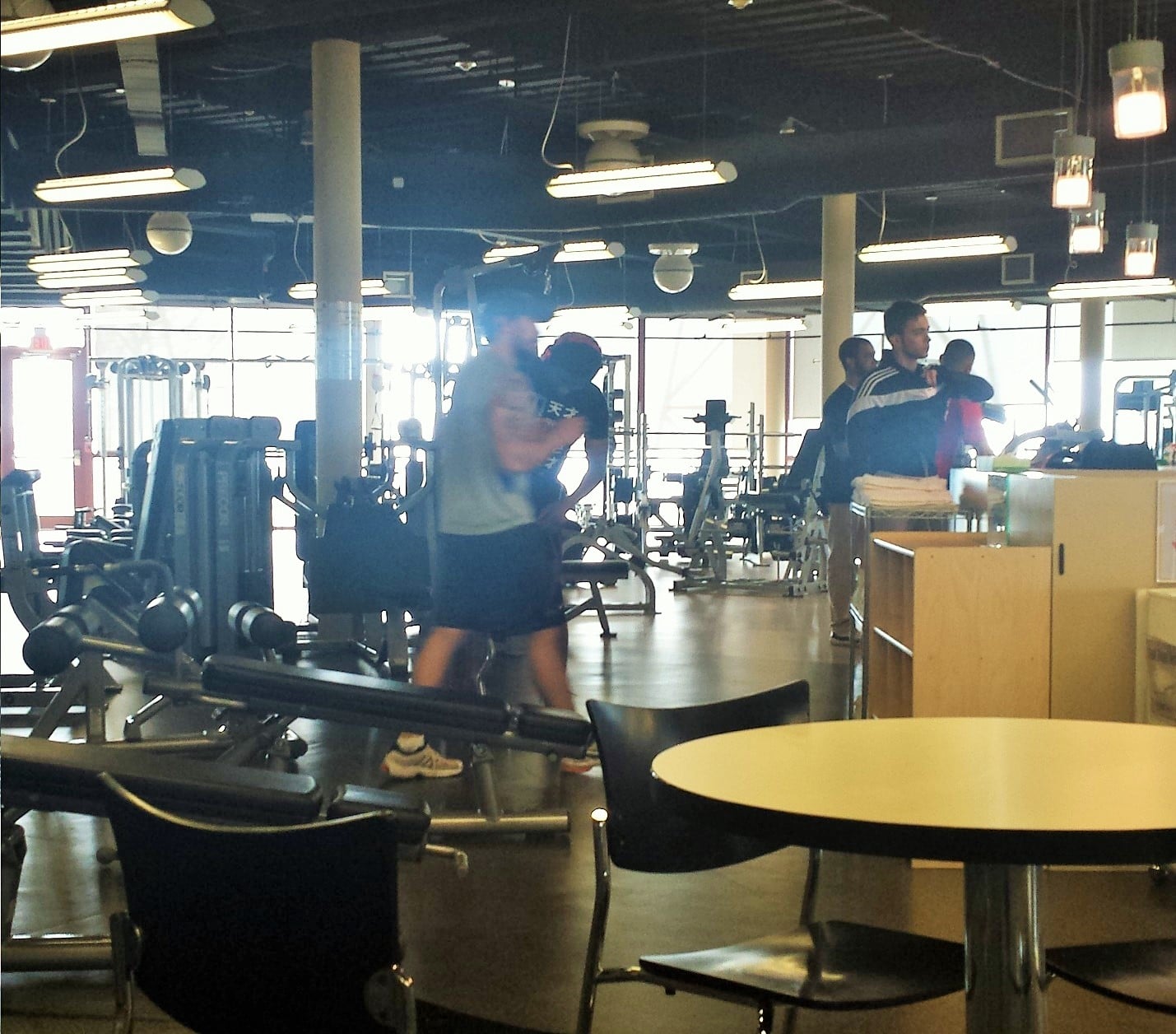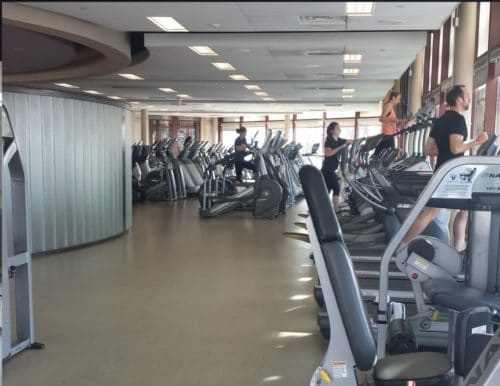
The upper floor of Montclair State’s Recreation Center houses the treadmills and ellipticals.
Photo by Victoria Testa
Montclair State University’s Student Recreation Center is brightly lit, with sunlight streaming through the floor-to-ceiling windows into the open-concept building. The area emanates a clean smell despite the smattering of sweaty bodies. Pop music sounds through the speakers, and the rhythmic pounding of determined feet hitting the treadmill can be heard from upstairs, paired with the occasional drop of a heavy weight onto the padded floor on the lower level. The machines sparkle like freshly-polished silver, and the building is at an unusually warm temperature. For a Friday morning, the place is busy, but not overly crowded by any means.
The lower floor seems popular, with two male staff members whispering to each other next to at least eight men using the large variety of weight machines, whose names sound as foreign as the instructions on how to use them. They form a small group near the entrance during their frequent drink breaks, creating an unintended separation between the compact weight area and the front desk.
At the top of the curved stairs, half a dozen women push themselves harder on treadmills, bicycles and elliptical trainers, despite the early hour. Around the corner, a couple of professors stretch on floor mats, and a very focused woman performs bicep curls in front of the mirror. Except for two staff workers and one brave man silently using equipment near the end of the row ― the women are left alone.
The Student Recreation Center is one of the biggest selling points for Montclair State, with its wide variety of activities, special events fitness and wellness programs and, of course, a well-equipped gym.
It’s promoted as “an integral part of the collegiate experience” on Montclair State’s website and is a center for student activity. While it is certainly an important asset for our campus community, the unspoken gender segregation has been known to loom over some students’ heads, the intimidation causing some to stray away from the center altogether.
A common observation in the campus community ― though one rarely spoken about openly ― is that the females typically stick to the upper level, where there are the majority of cardio machines, while males occupy the lower level, with the heavier weights and more intricate machines. Many of the regular attendees and staff members admit to noticing that the gender separation can happen, though accidentally.

The lower floor of Montclair State’s Student Recreation Center is almost always dominated by male students. Photo by Victoria Testa
Daniel Negroni, a senior biology major, and Carlos Andrade, a freshman film major, both utilize the facilities at the Recreation Center at least once during a typical week and agree that there can be an unplanned separation of the sexes that they argue is due to apprehension or embarrassment from gym users.
Andrade offered that “girls, or even guys, who are uncomfortable don’t come down [to the lower level]” while Negroni thinks “they may feel that they will get in everyone’s way.”
Jessica Testa, a sophomore psychology major, admitted to feeling intimidated on some occasions during her semi-regular trips to the Recreation Center: “I would love to go down to the bigger weights, but some guys can be very intimidating,” she said.
Nkechi Okpara, a first- year graduate student studying nutrition and food science, has been exercising at the Recreation Center every day for the past two semesters and admited to seeing the boy-girl separation at times: “I do see the segregation with the sexes, but I’m so pro-female lifting,” she said between her sets on the leg press, arguing that more women should use the lower level during their work out routines.
But, even Okpara admitted that it can be hard to overcome the intimidation. She offered some valuable advice for anyone feeling too intimidated to begin a routine of their own at the Recreation Center: “Everyone down there is the same as everyone up here. Don’t be intimidated. People are willing to help. I didn’t know what I was doing at first either. It’s hard and intimidating [to venture out and try something new], but just try it.”
The intimidation does not only affect females, though. Students and professors of all gender identifications are prone to never utilizing the Recreation Center if they do not overcome the misconceptions and are unaware of all that the center has to offer.
Romayne Eaker-Kelly, director of the Student Recreation Center, argued that the staff “does not promote the building as a fitness center but a recreation renter,” and tries their hardest to make sure students of all gender identifications feel comfortable enough to utilize every area of the building. “The Rec Center is a safe space on campus, welcoming to all,” she said.
When asked how the staff handles newcomers who are unsure of themselves or too intimidated to join in, she offered, “I explain to them that we will help them, spend time with them, teach them ― just let one of our professional staff know when they are coming and we will be there to spend time getting them more comfortable.”
Despite the pessimistic view from some, the truth is that the Student Recreation Center is built to make everyone feel welcome, safe and comfortable, whether they are working out, attending a class, doing homework, watching television, playing video games or just hanging out with some friends.

Students can watch TV and play video games at the Student Recreation Center.
Photo by Victoria Testa
And it’s not only athletes and fitness pursuers who can use the center’s offerings. In fact, a large variety of students and faculty visit the Recreation Center throughout their time at Montclair State.
According to Brian Batista, a freshman anthropology major and staff member at the Recreation Center, all types of people come into the building, and for a variety of reasons.
The biggest one, unsurprisingly, is using the Recreation Center as a built-in campus gym. “There’s always the regulars,” Batista said, referring to those students and faculty members that regularly work out in the Recreation Center or take part in the large variety of classes. These regulars range from determined first-semester freshmen to professors and graduate students.
Athletes also make an occasional appearance during their respective seasons. “The baseball players come in during the season and train together,” said Batista.
The Recreation Center also provides space for some personal “me time” for students from all years and majors. Nicole Ciuppa, another staff member and a sophomore nutrition major, said that “it’s mostly individuals [that come] to work out,” to have some time away from the busy schedules that can plague college students.
But small groups aren’t absent from the center, according to Batista. “Girls come in with each other and run on the treadmills and things like that,” he recalled. “A lot of friends come in together.”
Cardio machines seem to draw the most attention from small groups of friends, possibly because they allow for easy conversation across the treadmill handlebars.
The fitness classes offered by the Recreation Center are also popular with the campus community, with students from a variety of genders and ages enjoying the expansive schedule of classes offered at the center. The Group X classes are designed to be inclusive and cater to a variety of fitness interests and levels. Anyone is welcome to enjoy any of the classes offered, including Zumba, Pilates, Brazilian Jiu-Jitsu and Tae Kwon Do. These classes are among the places where the least gender separation occurs. Batista offered that “the guys usually like the HardCORE classes, but some do yoga and cycling too. It really doesn’t matter.”
And for those who don’t have fitness in their forte, all students are welcome to enjoy the center’s homey couch and television setups, complete with video games and a large DVD collection. For others, a quiet space with plenty of room to spread out and do homework or group projects is the most intriguing.
For anyone who is still too intimidated to take advantage of such an important aspect of our campus, Ciuppa offered a final thought: “Everyone is super friendly and supportive of each other. I would tell someone who is intimidated of the Rec Center that they should come in and see what it’s all about. We have something to offer everyone.”



